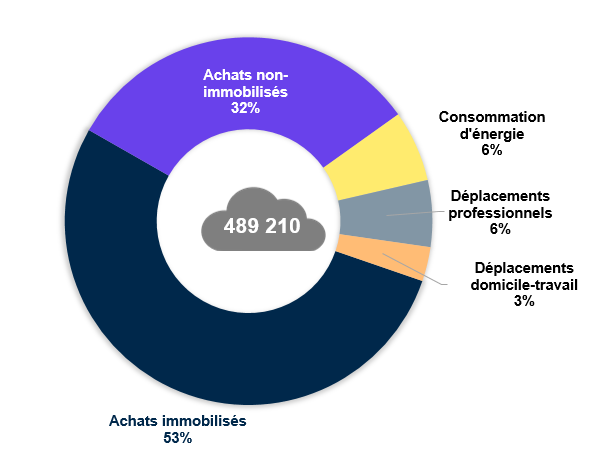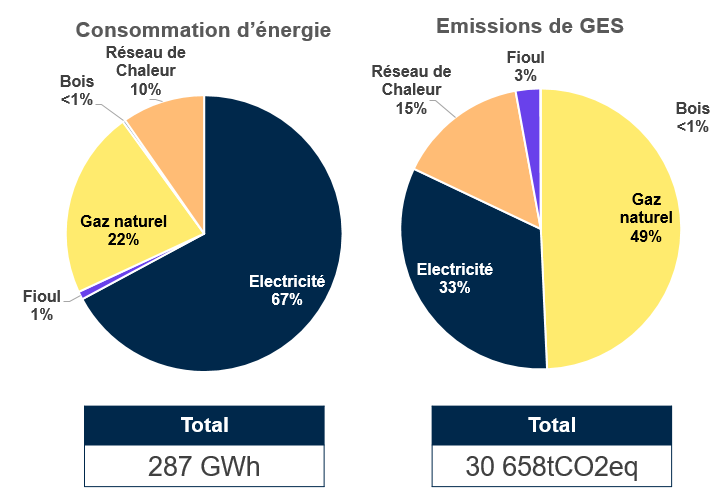The CNRS makes its second carbon footprint assessment
Following the CNRS's first carbon footprint assessment for 2019, the organisation has now published its second carbon audit for 2022. The latest report is more precise than 2019's, measuring the initial successes of our low-carbon transition plan while pinpointing methodological biases that need to be rectified to highlight the progress in sustainable purchasing made by the CNRS.
Three years after the CNRS's first greenhouse gas emissions assessment (BEGES1 ) and the 2019 launch of the organisation's low-carbon transition plan, the CNRS is repeating the exercise. The year 2022 is the subject of the new assessment which also has an extended scope. In total, the emissions produced by CNRS activities are equivalent to 14.7 tonnes of CO² per staff member whereas the figure had hit a peak of nearly 14 tonnes in 2019. This increase is mainly due to the assessment's extended scope as, for the new 'BEGES', the CNRS has taken sources of emissions into account that it was not possible to assess for the first assessment, particularly furniture, transport costs and transport equipment.
Greenhouse gases linked to purchasing account for 85% of the total assessed
If we take the same assessment scope as in 2019, between 2019 and 2022 carbon emissions will rise by 3% mainly due to increased so-called 'non-immobilised' purchases such as consumables and laboratory equipment. Purchases of this kind largely derive from the many successes of CNRS scientists in national and European calls for projects which often stipulate that purchasing new equipment is a prerequisite for the completion of a scientific project. Overall, 85% of the organisation's carbon emissions derive from fixed (scientific equipment) and non-fixed purchases, accounting for over 415 000 tonnes of CO² equivalent. This result clearly backs up the 2019 observation about the contribution of purchasing to the CNRS's carbon footprint although it should be noted that the current method of calculating emissions linked to purchases based on monetary ratios has its limits.
This method is based on the monetary volume of purchases because data on the physical quantities of purchases made is not available of course. The 1Point5 GHG tool developed by the research network of the same name includes a 'Purchases' module that can be used to associate an emission factor with each NACRE code2 by taking the specific nature of scientific purchases into account where possible. The CNRS has chosen to work with this method given that quantitative data is currently unavailable. The method does enable an estimation to be made of a laboratory's greenhouse gas emissions as a function of its expenditure but is unable to distinguish between eco-responsible purchases and more polluting purchases covered by the same NACRE code. For example, sustainable equipment bought for twice the price of low-cost equipment will represent two times the carbon emissions of its cheaper counterpart when in reality the figure should be much lower. Similarly, the same NACRE code is used for vegetarian and meat-based meals even though the carbon impact of meat products is of course known to be greater. To deal with this cause of confusion, Stéphane Guillot, the CNRS's scientific officer for sustainable development and risks, reassuringly explains us that "the CNRS is collaborating with the Labos 1Point5 research network (GDR) to put physical emissions factors based on the actual environmental characteristics of purchases in place of monetary emissions factors as these are useful but imperfect". The Ministry of Higher Education and Research has set up a working group aiming to develop a reference system of emission factors specific to research. Labos 1Point5, the CNRS and the French Agency for Ecological Transition (Ademe) are contributing to the group's work.
However, a methodological obstacle of this kind does not prevent efforts being made to reduce the environmental impact of purchasing. In fact, the CNRS had committed to reducing the carbon footprint of its purchasing even before the new BEGES was drawn up. Also, the organisation instructed its regional purchasers to include environmental criteria systematically in their formalised contracts in June 2023, three years ahead of the French civil service regulations on the subject. Alongside this, the first CNRS scheme to promote socially and environmentally responsible public procurement will be finalised in 2024 and has been designed to encourage responsible public purchasing. This scheme was jointly drawn up by the CNRS's Purchasing and Innovation Office (DDAI) and our regional purchasing officers. Locally, a growing number of laboratories are pooling equipment and setting up stockrooms of consumables.
- 1Bilan d'émissions de gaz à effet de serre.
- 2Nomenclature Achats Recherche Enseignement Supérieur = Nomenclature for research and higher education purchases. This was introduced on January 1st 2014 following collective work by French stakeholders in science. Its primary objective is to verify the value of articles bought by a purchaser with regard to price thresholds set out in the French Public Procurement Code.
Energy and travel expenses - the successes of the low-carbon transition plan
This increase in the contribution of purchases in the CNRS's BEGES can also be explained by the fall in the share of other carbon emissions resulting from the initial success of the CNRS low-carbon transition plan. Major building works to improve thermal insulation or recover waste heat from certain energy-intensive equipment have enabled the CNRS to cut its energy consumption by 6% which includes 10% for gas, 14% for heating networks and 16% for fuel oil.
Travelling to work (3% of the total) can also be seen to have changed significantly. In 2019, 34% of staff members' daily journeys were by motor vehicle, accounting for 79% of carbon emissions in this area. However, in three years the use of vehicles has gone done by 10% while active mobility (walking, e-scooters, cycling) has increased by 20% to become the main mode of daily travel (37%) for the CNRS's 33,000 staff members. CNRS teams won the national 'Mai à vélo' (May on a bike) challenge this year for the first time under the same CNRS banner which testifies to how travel practices have changed. This increase in active mobility has a positive impact on public health as well as its effect on the CNRS's carbon footprint as it has been estimated that every kilometre cycled to work saves around one euro in health costs in France1 .
- 1https://theconversation.com/le-velo-un-potentiel-inexploite-pour-ameliorer-la-sante-et-le-climat-225010
However, the most significant reduction is in the costs of travel for work purposes (6% of the BEGES) for the simple reason that air travel, the most costly means of transport in terms of greenhouse gas emissions, was halved between 2019 and 2022. Of course this spectacular reduction can be explained by economic factors – the Covid-19 pandemic led to the forced closure of many countries, particularly in Asia – and more structural reasons like changes in individual and collective practices. The latter changes include fewer participants actually attending international conferences, and the increased use of videoconferencing systems to facilitate interaction and trains for travel within Europe. The CNRS has already observed a modal shift from air to rail use reflected by the 6% increase in train journeys in the latest BEGES compared with its predecessor. As the travel manager with the CNRS's Purchasing and Innovation Office, Jean-Luc Marchon is well aware of these changes in practices and notes the CNRS's pioneering nature in this area: "The CNRS was the first client to ask our contract holder to integrate the travel policy rules deriving from the State's energy sobriety plan into its online booking tool for nearly thirty of our staff members' most requested French and European destinations. This will be operational in spring 2025. It took just three months for the CNRS to become the first public sector organisation to comply with the new regulations in such a detailed way. We removed all flight destinations from the tool that could be reached in under than 4 hours by train"..
From the carbon footprint to our impact on biodiversity
The CNRS's latest BEGES is thus more robust than its predecessor which, as Stéphane Guillot explains, shows the organisation now knows how "to strike the right balance between optimising its carbon footprint and maintaining the highest international level of research particularly into the environmental transition which could produce more solutions".
Also, as Blandine de Geyer, the organisation's national sustainable development officer, points out, "the carbon footprint is just one part of an organisation's environmental assessment. It's also important to take its equally important impact on biodiversity into account". Although this impact is more complex to measure, the CNRS is launching a project to do so in the framework of its new overall sustainable development and social responsibility plan. This will enable the organisation to develop a more systemic approach by also integrating water and waste, particularly of plastics which are only very partially taken into account by the carbon footprint.
This approach fits with Stéphane Guillot's view of the environmental transition as "a strategic opportunity and not a constraint" for the CNRS.




